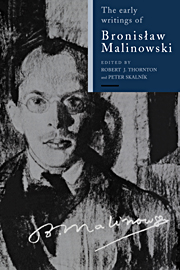Book contents
- Frontmatter
- Contents
- Preface
- Acknowledgements
- Note on the text
- Introduction: Malinowski's reading, writing, 1904–1914
- Malinowski's writings, 1904–1914
- 1 Observations on Friedrich Nietzsche's The Birth of Tragedy (1904/5)
- 2 On the principle of the economy of thought (1906)
- 3 Religion and magic: The Golden Bough (1910)
- 4 Totemism and exogamy (1911–1913)
- 5 Tribal male associations in Australia (1912)
- 6 The economic aspects of the intichiuma ceremonies (1912)
- 7 The relationship of primitive beliefs to the forms of social organization (1913)
- 8 A fundamental problem of religious sociology (1914)
- 9 Sociology of the family (1913–14)
- Notes
- References
- Index
5 - Tribal male associations in Australia (1912)
Published online by Cambridge University Press: 18 December 2009
- Frontmatter
- Contents
- Preface
- Acknowledgements
- Note on the text
- Introduction: Malinowski's reading, writing, 1904–1914
- Malinowski's writings, 1904–1914
- 1 Observations on Friedrich Nietzsche's The Birth of Tragedy (1904/5)
- 2 On the principle of the economy of thought (1906)
- 3 Religion and magic: The Golden Bough (1910)
- 4 Totemism and exogamy (1911–1913)
- 5 Tribal male associations in Australia (1912)
- 6 The economic aspects of the intichiuma ceremonies (1912)
- 7 The relationship of primitive beliefs to the forms of social organization (1913)
- 8 A fundamental problem of religious sociology (1914)
- 9 Sociology of the family (1913–14)
- Notes
- References
- Index
Summary
Secret societies are widespread social institutions among wild and barbarous peoples. The great importance of secret societies for the social organization of such peoples is well known through the works which deal with this subject in general, and through various monographs, describing secret societies in various communities. As yet there is no monograph concerning tribal associations of males in Australia, although it is precisely in that country that these societies flourish extremely; and we possess abundant ethnographic materials concerning them. Although in the well-known treatise of Prof. Hutton Webster these Australian data are treated in masterly fashion, it is nevertheless possible for a special monograph to outline certain features and to attain certain theoretical results for which there is no room in a general treatise.
As is well known, the Australian savages stand on a very low level of culture, and have but primitive forms of social organisation. The rudimentary government of a tribe, or rather of a local group, consists of a headman and of a council of elders. Broadly speaking, the old men wield the real power; but to understand the basis of this power, an investigation into the organization of the tribal society of males is necessary.
The kinship organization in Australia presents two aspects: there is the family and, corresponding therewith, individual kinship; besides this, there is the division into exogamous classes, totemic clans and other analogous groups. To this division correspond the systems of tribal or group kinship, embodied in the well-known kinship terms.
- Type
- Chapter
- Information
- The Early Writings of Bronislaw Malinowski , pp. 201 - 208Publisher: Cambridge University PressPrint publication year: 1993



